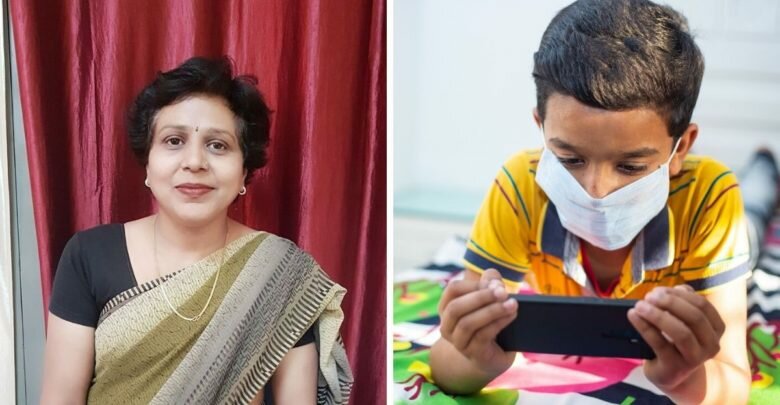5-Step-Plan to Teach-Students during Lockdown

5-Step-Plan to Teach-Students during Lockdown
New Delhi: Pinki Gupta, Principal of Navyug School, Darbhanga House in Delhi, was used to busy working days. She would wake up at 4.30 am, attend to household chores, and leave her home in Dwarka at 7.30 am to drive for an hour to reach her school. School hours would end at 2.30 pm, and she would spend a couple of hours wrapping up official work before taking the long drive back home.
With India in lockdown since March 23, most would think she is having it easy at home. But this is not the case. She was quick to adapt to the changing circumstances and foresaw that reopening the school would have dire consequences on her staff and students.
This is true for all first-movers among the school leaders we have been working with. They could all hear the ‘learning-crisis’ bell ringing loud and clear.
5-Step-Plan to Teach-Students during Lockdown
The foremost problem that school leaders like Pinki Gupta wanted to tackle was engaging students in their homes and ensuring continuity in learning. They knew from experience that even when a child missed a week of school to attend familial functions, teachers had to put extra effort to bring them up to speed when they returned. At times, school leaders had to volunteer to help those teachers.
And now, with the lockdown lasting nearly four months and the possibility of school closures for an undefined time, the stakes are high. The improvements students made in the last few years could all slide back.
So, what are school leaders like Gupta doing?
She has devised a simple 5-step plan to ensure learning and engage students at their homes.
Step 1- Getting everyone together
Gupta’s first step was to bring all her people (staff and students) on a common platform. Teachers added all students/parents in grade-wise WhatsApp groups. When a significant number of students were missing from those groups, the teachers called the parents and got their alternate WhatsApp numbers or asked them to download the application if they had a smartphone.
Gupta says she was able to ensure 85 per cent of her students in the WhatsApp groups through this exercise. The teachers were also part of the groups, according to the grades they taught.

5-Step-Plan to Teach-Students during Lockdown
Step 2- Making a time-table
The other characteristic was adherence to a timetable. And surprisingly, it did not differ much from the usual school timetable. There were, of course, certain adjustments.
Gupta decided a two-hour time slot (8.30-10.30 am) for teachers to assign some work to their students. The students complete the tasks in the course of the day and submit their work between 4-5 pm.
One of the early trends that emerged in low-income households was that it was nearly impossible to slot a fixed time for teaching and learning. Every household had its challenges, and as parents were important stakeholders, a good degree of flexibility was required for them to assist their children.
5-Step-Plan to Teach-Students during Lockdown
Leela Devi, mother of fifth grader Abhishek, shares that she had to ask her relatives to recharge her phone with a ‘data pack’ as they were in debt of forty thousand rupees this year. Their sole bread earner, her husband, lost his job in January. She described with sadness how she dug up old notebooks and tore their empty pages to stitch them together and make a new notebook for her son.

Ram Singh, father of fifth grader Anamika, says that he had to initially borrow a mobile phone from his neighbour for Anamika’s studies. He would have to leave home in the mornings for his work as a driver and Anamika would not have access to his phone. But now, with a fixed morning schedule when Anamika is expected to use her phones, he does not have to borrow a neighbour’s device.
Step 3- Teachers giving tasks
One of the reasons to give a two-hour window for teachers was to keep them relatively free for the rest of the day. Most school leaders understand that working while managing household chores is a difficult juggle. Thus, the time allocation, along with the tasks had to be done in a way that it did not burden the teachers.
5-Step-Plan to Teach-Students during Lockdown
Moreover, the kind of tasks were also important. They needed to be simple enough for students to understand and work on, as well as interesting enough to engage them.
Typically, teachers sent photos of content followed by an audio message. Then, a short assignment was given with two or three questions that students needed to answer. Sometimes the tasks were complemented by video links and photographs.
Here is an example of how a teacher taught angles through WhatsApp.
Step 4- Cold-calling students to submit their work
The tasks given out to the students were short and crisp, and most enjoyed working on them. And it did not take a lot of their time. But there was one problem some school leaders faced–an overwhelming number of student responses after they finished their work–everyone wanted feedback from the teachers!
5-Step-Plan to Teach-Students during Lockdown
As it was difficult to evaluate every line through WhatsApp, the teachers at Pinki Gupta’s school decided to cold-call students to submit their work–telling them not to submit their work unless being asked. This helped the teachers control student responses while ensuring that they received responses from only those students who they could attend to at that time.
Step 5- Giving feedback
This is the final step to close the virtual teaching-learning cycle for the day. When a select few students submitted their work, it was time for the teachers to evaluate them. This had its own challenges but most teachers worked their way around by doodling on WhatsApp.
The feedback was probably not as detailed as it would have been in a physical evaluation, but this challenge was tackled with the help of audio messages, especially when teachers found students lacking in understanding. The teachers also sent answer keys for self-evaluation.
School leaders like Pinki Gupta put support structures to drive this 5-step daily learning process. There were also cultural nudges to keep the spirit of the school alive.
- Weekly teacher meetings
School leaders lead weekly meetings to bring teachers together to reflect and plan. Pinki Gupta is present in all their grade-level WhatsApp groups, observing the best practices and sharing these with all the teachers. She also talks about the processes followed by other schools that she picks up from the conversations with her peers.
Based on these discussions, teachers plan their upcoming week. Gupta also takes the opportunity to appreciate their hard work and highlight the efforts of individual teachers.
- Adapting Quickly
Who would have imagined that even music could be taught through WhatsApp! At Navyug School, the music teacher, Anish, adheres to the timetable and teaches music how he would have done in a physical classroom. He sends a new song/prayer and asks the students to sing along.
Of late, he has even started conducting morning assemblies, where he sends prayers everyday and the students sing them at the same time.
Gupta opines that Music is one of the most sought-after classes and that students look forward to it. Fifth grader Abhishek says that he records a song multiple times to get the perfect tune. He says he loves singing and looks forward to the morning assembly and Anish sir’s music class.
- Connecting to the ‘last-mile’ students
Gupta accepts that only 85 per cent of students are included in the WhatsApp groups, which is a feat in itself. She says that the rest either do not have smartphones or could not be reached by the teachers.
5-Step-Plan to Teach-Students during Lockdown
Teachers call these students and assign them the tasks over the phone, ensuring some form of engagement. Even then, around five per cent of students are not reached by the teachers. Gupta is persistent in getting them into the fold through the help of other parents and social workers.
- Hosting Events
One of the happiest things about school for a child is the multitude of cultural events and activities. Gupta did not let virtual communication obstruct such events.
She arranged a ‘fancy-dress competition’ for first and second-grade students, where they had to wear an outfit in their favourite colour and parents sent their pictures in the WhatsApp groups. Gupta also asked students to record an audio message about why that particular colour was their favourite, and list other objects that bear the same colour. A smart mix of education with fun!
- Engaging parents
School leaders like Gupta admit that all these would have been uphill tasks without the support of parents. Gupta sends out messages to parents motivating them to support their children. She even calls them occasionally to check on them.
- Leading from the front
While Gupta takes an active role in managing the virtual engagement strategy, she does not shy away from teaching. Being a Math teacher, she started rolling out a series of videos under the theme ‘Math-Magic’, eliciting awe among her students. Doing this makes teachers look up to her as someone leading the cause of learning from the front.
Sonia Chandna, a teacher at the school, says that she was inspired when she saw Principal Gupta making videos for students. She made some videos after that. She adds that she gets ideas from Gupta’s work which help in her teaching too.
The COVID-19 crisis has posed significant challenges to the continuity of teaching and learning. But the sooner school leaders adapt to the situation, the faster they can learn and mitigate the damages to students.






